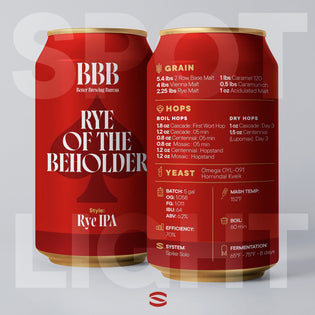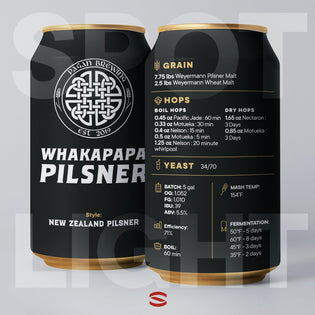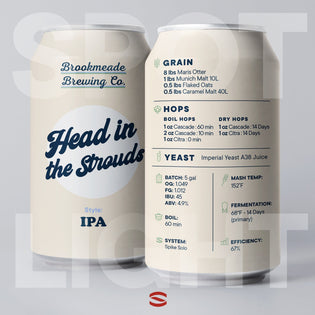
The Brewer: Matthew Bush
Hi, I'm Matt. I've been brewing as Flat Roof Brewing for the last decade, and currently live in Grand Rapids, MI. I make beer that embodies the rich tapestry of people, places, and experiences that inspire me in the Great Lakes region — brewed on a slight slant from the Furniture City.

The Beer: Gose
My go-to Gose recipe uses the kettle sour method to reach the acidity level that this saline sipper is known for. This is achieved by a short boil, followed by holding the wort at 90F (make sure the kettle is covered) for roughly 24-48 hours to let the lacto culture reduce the pH. After this, simply bring to another boil and continue as with any other brew day. This is all made super easy with the seamless temperature control of the Solo.
The malt bill is extremely simple and light, about 50/50 pilsner:wheat. For an added bit of fun, I treat the base recipe differently for a rotating series highlighting seasonal fruit with a touch of baked confectionary flavor & aromatics. To achieve this, I add a touch of honey and biscuit malt, which pair beautifully with very restrained cinnamon and vanilla for a waft of pie crust. I like to use whatever fruit is in season, but one of my most popular is the tart key lime pie variant shown in this recipe.

I typically make a tincture with all the adjuncts by steeping in neutral grain spirit and add in at packaging, but you could also let the beer rest on them post fermentation. If you'd like to brew the base version, simply leave out the adjuncts (aside from coriander and sea salt, which are added at the end of the boil) and replace the specialty malts with an equal amount of base grain.
The Recipe: Market Stand Gose

INGREDIENTS
GRAIN
- 5 lbs White wheat
- 4 lbs Pilsner
- 12 oz Honey malt
- 12 oz Biscuit malt
WATER
- 4 g CaCl2
- 0.7 g CaSO4
- 20 g Sea salt
- 3 ml Lactic Acid
ADJUNCTS
- 1 Vanilla Bean
- 1 Cinnamon Stick
- 4 limes Lime Zest
- 4 oz key lime extract
- 20 g Coriander (at end of boil)
YEAST
- Omega Lacto Blend
- Hold at 90F until 3.5pH (or to taste) Omega Kolsch

INSTRUCTIONS
BATCH SIZE: 5 gal
OG: 1.051
FG: 1.013
IBU: 0
ABV: 5.0%
EFFICIENCY: 66%
MASH TEMP: 152ºF
BOIL:
- 5 min before kettle souring
- 45 min
FERMENTATION:
- 90ºF - ~2 days (lacto fermentation)
- 68ºF - 10 days (primary fermentation)
SYSTEM: Solo

Want more from Matt? Check out his latest blog on Low Oxygen Practices for Hoppy Beers.
Cheers
Matthew Bush - Flat Roof Brewing
Spike Summarizes: All Things Gose Beer
What is a Gose Beer?
Gose (pronounced gose-uh) is a historical beer style that hails from Germany, specifically the town of Goslar, after which it's named. It's a unique, tart, slightly salty, and often citrusy wheat beer, known for its distinct flavor profile and brewing process.
What distinguishes Gose from other beers?
Gose sets itself apart from other beers through its distinct ingredient list and fermentation process. Traditionally, Gose uses coriander and salt, which are usually not common in beer brewing. Its distinct fermentation process involves spontaneous fermentation, similar to Belgian lambics, creating a subtle sourness and complexity.
What's the history of Gose beer?
The history of Gose is an intriguing tale of a beer style nearly lost to oblivion but miraculously resurrected. First brewed in the 16th century in the German town of Goslar, Gose took its name from the Gose River, which supplied the water for brewing. The style fell into obscurity post-World War II, but was resurrected in the 1980s in Leipzig and has since enjoyed a worldwide renaissance.
What does a Gose taste like?
In terms of flavor, Gose is a symphony of sour, salty, and herbal notes, complemented by a refreshing citrusy tartness. The wheat base lends a bready undertone, while the unique use of coriander imparts a subtle spice. The salinity, though surprising, adds balance to the overall tartness.
How is Gose beer made?
The Gose brewing process is both traditional and distinctive. It involves a mixed fermentation with top-fermenting yeast and lactic bacteria, which provides the beer's characteristic sourness. The addition of salt and coriander occurs towards the end of the boil. The final product is then often bottle-conditioned, allowing for additional complexity to develop.
What are the essential ingredients in a Gose?
The ingredients that define a Gose are malted wheat and barley, coriander, and salt. The wheat gives the beer its light, crisp character, while the coriander and salt create the unique flavor profile. Yeast and lactic bacteria are used for fermentation, contributing to the beer's sourness.
What foods go best with a Gose?
Gose is a fantastic companion to a variety of foods, thanks to its acidity and salinity. It pairs wonderfully with grilled seafood and fresh salads, and its tartness can cut through rich, fatty foods like fried chicken or creamy cheeses. The salinity of Gose can also complement sweet desserts, creating a savory-sweet balance.
Is Gose a year-round beer?
Yes, Gose is indeed a year-round beer, but its refreshing and tart qualities make it particularly suited to warmer months. However, the evolving craft beer landscape has seen variations of Gose brewed with fruits and spices, making it enjoyable in all seasons.
How strong is a typical Gose?
A traditional Gose is generally on the lower end of the alcohol spectrum. It usually ranges from 4.0% to 5.0% ABV, making it a light and sessionable choice, perfect for occasions where you'd like to enjoy a few without feeling too weighed down.
Are there different types of Gose beers?
There are indeed variations of Gose beers, particularly in the modern craft beer scene. Many breweries experiment by adding fruits like raspberry, mango, or passion fruit, enhancing the beer's tartness and complexity. Others have even incorporated ingredients like chili peppers, creating a spicy and tart blend.
What's the correct temperature for serving Gose?
The optimal serving temperature for a Gose is between 40 and 45 degrees Fahrenheit (4-7 degrees Celsius). This temperature allows the beer's complex flavors and refreshing tartness to shine without being too cold to suppress these subtleties.
What are some popular brands of Gose?
There are several breweries worldwide known for their excellent Gose beers. Germany's Bayerischer Bahnhof is famous for its traditional interpretation, while American breweries like Westbrook Brewing Co., Victory Brewing, and Anderson Valley Brewing have gained popularity with their innovative versions.
Why does Gose have a golden color?
The golden color of Gose comes primarily from the wheat and barley malts used in the brewing process. The type and amount of malts used can affect the hue, resulting in variations ranging from pale straw to deep gold.
How does the brewing process affect Gose's flavor?
The unique brewing process of Gose significantly influences its flavor profile. The mixed fermentation with yeast and lactic bacteria imparts a slight tartness. The addition of coriander and salt during the boil brings in the characteristic spiced and salty notes. The beer's complexity deepens with the final step of bottle conditioning.
Are Goses more sour than other beers?
Yes, Gose beers are typically more sour than most beer styles, but less so than certain Belgian styles like Lambic or Gueuze. The level of sourness varies based on the specific brewing process and the amount of lactic bacteria used during fermentation.
Why is Gose often served in a specific type of glass?
Gose is traditionally served in a tall, narrow glass called a 'Stange'. The slim shape helps maintain the beer's head and concentrates its delicate aromas, enhancing the overall tasting experience.
Is Gose beer good for beginners?
Gose can be a great choice for beer beginners thanks to its light body, refreshing tartness, and lower alcohol content. However, the unique sour and salty flavors may be a surprise for newcomers, so it's often considered a beer for more adventurous palates.
How does Leipzig Gose differ from Goslar Gose?
While both styles hail from Germany, Leipzig Gose and Goslar Gose have subtle differences. Goslar Gose tends to be slightly more balanced with a softer sourness, while Leipzig Gose often has a pronounced tartness and a touch more salinity. These differences are mostly due to variations in local water composition and brewing traditions.
Where can I buy the best Gose beers?
You can find top-quality Gose beers at well-stocked liquor stores, beer specialty shops, or directly from breweries. Online beer retailers also offer a wide range of domestic and international options. Always remember to check the packaging dates to ensure you're getting the freshest beer.
What are some award-winning Gose beers?
Over the years, several Gose beers have taken home prestigious awards. Leipzig's Bayerischer Bahnhof Original Leipziger Gose is a classic favorite, while in the U.S., Anderson Valley's The Kimmie, The Yink, and The Holy Gose, as well as Westbrook's Gose, have all earned accolades at beer competitions.
What's the shelf life of a Gose beer?
Gose beers, especially those without additional fruit or flavorings, typically have a shelf life of up to six months. This is because Gose beers are more sensitive to changes in flavor over time due to their lower alcohol content and acidity. Always check the beer's packaging date to ensure its freshness.
How can I homebrew a Gose beer?
Homebrewing a Gose beer can be an exciting venture for the adventurous homebrewer. You'll need a good quality base malt, malted wheat, coriander, salt, yeast, and lactobacillus bacteria for souring. The process involves traditional brewing stages with the extra step of souring the wort before boiling and fermenting. However, keep in mind that brewing a Gose requires careful control to achieve the right balance of flavors.
Why do some Gose beers have a coriander aroma?
The aroma of coriander in Gose beers comes from the addition of ground coriander seeds during the brewing process. This ingredient imparts a characteristic spicy, citrusy, and herbal aroma that enhances the overall complexity of the beer.
Is Gose beer suitable for vegan diets?
Most Gose beers are suitable for vegan diets as they are typically brewed using water, grain (malted wheat and barley), hops, yeast, salt, and coriander - all plant-based ingredients. However, it's always good to check with the brewery, especially if the beer has additional flavorings or adjuncts, which may not be vegan.
How is the salt content regulated in Gose beers?
Regulating the salt content in Gose beers is a key aspect of the brewing process. The brewer determines the salt content based on the desired flavor profile. It's a delicate balance - too much salt can make the beer overly saline and unpalatable, while too little may not achieve the characteristic Gose flavor.
Are there non-alcoholic Gose beers?
Yes, with the rising demand for non-alcoholic options, some breweries have started producing non-alcoholic Gose beers. These beers aim to provide the same tart and refreshing flavor profile of a traditional Gose but without the alcohol.
What's the future of Gose beers in the craft beer industry?
Given its recent revival and increasing popularity among craft beer enthusiasts, Gose is expected to have a promising future in the craft beer industry. The style's unique and versatile flavor profile makes it an excellent canvas for brewers to experiment with new ingredients and brewing techniques, ensuring that Gose will continue to evolve and excite beer lovers worldwide.
Can I age my Gose beer?
While some beers improve with age, most Gose beers are best enjoyed fresh. This style is designed to be light, tart, and refreshing, qualities that can diminish over time. Aged Gose may also risk a rise in unwanted flavors or a drop in overall quality.
What's the impact of water quality on Gose beers?
Water plays a crucial role in all beer styles, including Gose. Given that Gose originated in Goslar, where the local water was slightly salty, this contributed to its characteristic flavor. Today, brewers often adjust their water profile (adding minerals or salts) to mimic the water qualities of Goslar, ensuring an authentic Gose flavor.
What's the caloric content of a Gose beer?
The caloric content of Gose beers can vary, but they're generally lower in calories compared to heavier beer styles due to their lower alcohol content. A standard serving of Gose might contain between 120-150 calories, but this can vary depending on the specific recipe and any additional ingredients used.
Why is Gose often referred to as a 'wild beer'?
Gose is sometimes referred to as a 'wild beer' due to its use of spontaneous or mixed fermentation. This process introduces wild yeasts or bacteria (like lactobacillus), which gives the beer its distinctive tartness and complexity, making Gose part of the broader category of sour and wild beers.
What is the role of lactobacillus in brewing Gose?
Lactobacillus, a type of bacteria, plays a key role in brewing Gose. It is responsible for souring the beer, consuming the sugars in the wort (unfermented beer) and producing lactic acid. This process imparts Gose with its characteristic tartness and enhances its overall flavor complexity.
Are Goses similar to Belgian Lambics?
While Gose and Belgian Lambics both fall under the category of sour beers and use a form of spontaneous fermentation, they are quite distinct. Lambics are typically more sour and complex, undergo a longer aging process, and do not have the salinity or spice (coriander) characteristics of a Gose. Furthermore, Lambics are strictly Belgian, while Gose is German in origin.
How should I store Gose beers?
Gose beers should be stored upright in a cool, dark place. This helps prevent oxidation and keeps the beer fresh. Since Gose beers are best enjoyed fresh, they should be consumed relatively soon after purchase.
How do Gose beers compare to other sour beers?
While both Gose and other sour beers share a tart flavor profile, they can vary significantly in taste and brewing techniques. Gose is distinguished by its salt and coriander addition that imparts a unique salinity and herbal spice. Other sour beers, such as Berliner Weisse or Flanders Red Ale, lack these elements but may offer different layers of complexity and varying degrees of sourness.
Can I cook with Gose beer?
Absolutely, Gose beer can be an excellent ingredient in various recipes. Its sourness can tenderize meats in marinades, its citrusy notes can brighten up seafood dishes, and its subtle salinity can enhance the flavors in stews and soups. You can also reduce it into a syrup for desserts, offering a unique, tangy twist.
Are there gluten-free Gose beers?
While traditional Gose beers contain malted barley and wheat, some breweries are producing gluten-free versions using gluten-free grains like sorghum, millet, or buckwheat. However, availability may vary, and it's always wise to check the label or with the brewery for confirmation.
What is the IBU of a typical Gose?
The International Bitterness Units (IBU) measure of a Gose is generally quite low, typically between 10 to 15 IBU. This low bitterness allows the sour, salty, and citrusy flavors of the Gose to take center stage.
Why is Gose sometimes considered a 'craft beer'?
Gose is often considered a craft beer because it's a traditional style that has been embraced and innovated by craft breweries. Its unique flavor profile and the skilled brewing techniques required to balance its sourness and salinity embody the creative spirit of the craft beer movement.
Can Gose beers help with hydration?
While Gose beers are refreshing and contain salt, a known electrolyte, they shouldn't be relied upon for hydration. Alcohol has a diuretic effect, meaning it can lead to increased dehydration. So, always remember to drink water alongside your beer, especially in hot weather or when consuming alcohol over extended periods.
What's the cultural significance of Gose in Germany?
Gose holds a unique place in Germany's rich beer history. Originally brewed in Goslar, and later adopted by Leipzig, it's a part of the region's cultural and brewing heritage. Even today, the city of Leipzig considers Gose its official beer style.
Why is Gose beer sometimes cloudy?
Gose beer is often cloudy due to the high proportion of wheat used in brewing, which contributes to the haze in the final product. Additionally, Gose beers are traditionally unfiltered, meaning yeast and other particulates remain in the beer, adding to its cloudiness.
Are Gose beers always tart?
While Gose beers are known for their tartness, the intensity can vary. Factors such as the amount of lactic bacteria used, the duration of souring, and the addition of fruits or other flavorings can all affect how tart a Gose tastes. However, some level of tartness is generally expected in this style.
What impact does the coriander have on the Gose beer flavor?
Coriander, a key ingredient in Gose beers, imparts a distinctive spicy and citrusy flavor. While not overly dominant, this subtle addition complements the tart and salty profile of the beer, adding complexity and depth.
Are Gose beers available worldwide?
Yes, thanks to the global craft beer movement, Gose beers are now available worldwide. Many breweries across Europe, North America, and beyond have embraced this unique style, creating their interpretations. However, availability might vary, so it's always a good idea to check with local craft beer outlets or online beer marketplaces.





